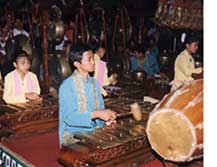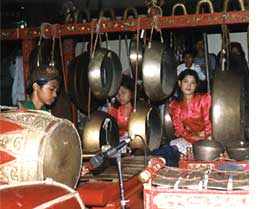|
JAKARTA (indo.com): As a highly respected (and sometimes
considered "sacred") musical instrument, gamelan instruments
are well preserved at the National Museum, with levels of
humidity being regularly observed.
All kinds of metal items are subject to decay and bronze
gamelan is no exception. "Gamelan quickly rusts unless the
level of humidity is carefully controlled," conservationist
Subanto told indo.com here recently.
Rust is the great enemy of gamelan it can greatly effect
the instruments' sound. "To avoid the rust, we protect the
gamelan by 'coating' or polishing it with chemical material,"
he added.
However, the 'coating' is made in such a way that it will
not affect the instrument when played. "Principally, efforts
to conserve all cultural items or national heritages stored
at the museum, including gamelan, are made to ensure their
durability," he said.
He acknowledged that the vast collections at the museum
and the lack of funds sometimes posed a problem for the
conservation team to work.
The National Museum has five sets of gamelan, originating
from Java (from the 1940s), Bali (1940s), Banten (eighteenth
century), Sunda, West Java (1920s) and Banjar (1920s).
Gamelan are basically percussion orchestras featuring brass
kettle gongs that are struck with velvet-covered wooden
mallets.
Western World
The western world first heard of the gamelan through the
reports of Sir Francis Drake in 1580. Some 250 years later,
Sir Stanford Raffles provided a detailed account in his
famous work, The History of Java; and a gamelan was brought
in to delight audiences at the World Expo in Paris in 1870.
Study of gamelan music began to be seriously undertaken
by Dutch scholars at the beginning of the 20th century,
and the queen of Holland sometimes entertained her guests
with performances.
Gamelan study has been gaining popularity in universities
throughout North America and Europe, where ethnomusicology
students learns gamelan theory and practice, some continuing
on to get doctorates in this field. Junior high schools
in Great Britain include gamelan music in their curriculum.
This has resulted in many gamelan groups and centers in
such places as the South Bank Center in London. Some of
them have constructed their own gamelan instruments, always
based on Indonesian gamelan principles.
Therapeutic Tools
Gamelan Sekar Jaya, a Balinese Gamelan orchestra in America,
is just one of the foreign gamelan ensembles that have made
their debut. In Japan, the Javanese gamelan is being used
as a therapeutic tool for the physically and mentally deprived;
it has been an integral part of komodo no shiro (children's
palace) since the institution's inception. Komodo no shiro
is a cultural center for children under the care of the
Department of Welfare. The Japanese regard the gamelan as
a suitable instrument for children under the care of the
Department of Welfare, as well as for children's musical
development and to help Japan return to its own traditional
music.
 One
Japanese musicologist reports that Gamelan has proven attractive
to children because it is easy to play. The roundness of
its components provides tranquility, steadiness and strength
to the children. They are able to feel the vibrations produced
by the instruments. Indirectly, the gamelan has also taught
children to socialize because of the many possibilities
in combination with other instruments which requires many
players and close cooperation. One
Japanese musicologist reports that Gamelan has proven attractive
to children because it is easy to play. The roundness of
its components provides tranquility, steadiness and strength
to the children. They are able to feel the vibrations produced
by the instruments. Indirectly, the gamelan has also taught
children to socialize because of the many possibilities
in combination with other instruments which requires many
players and close cooperation.
The preferred gamelan forms overseas are those of Bali and
Java, of which there are many variations, although many
other less complicated forms from other parts of Indonesia
await discovery. One consequence of all this interest is
the development of the gamelan's musical idiom and the mode
of expressing a work. Such modification has given rise to
the term, 'contemporary gamelan', as opposed to 'classic
gamelan'. The latter refers to a musical form that continues
to be based on classical principles in which aesthetics
and artistic expression must be structured in certain forms.
The 'contemporary gamelan' is a new creation which does
not follow classical principles; the important things is
to find the right sound and color to express the desired
feeling.
The desire of foreign gamelan devotees is not just to be
able to play the gamelan, but also to visit the country
of origin. In Yogya and Solo (Central Java) as well as Bali,
it is common to meet groups of foreigners studying gamelan
music. They have generally mastered the technique and are
there mainly to absorb the culture that goes with the gamelan.
The atmosphere created by the sounds of gamelan music in
its country of origin would certainly differ to that in
their own country; here in Indonesia they can feel the cultural
unity more strongly.
 Gamelan
music of all kinds, in Indonesia and around the world, is
supported and documented by the American Gamelan Institute
(AGI), an organization devoted to publishing, recording,
distributing and making available information on all aspects
of Indonesian performing arts and their international counterparts.
Gamelan is so popular that the name 'gamelan' is used as
a name of an overseas website specializing in information
technology. Gamelan
music of all kinds, in Indonesia and around the world, is
supported and documented by the American Gamelan Institute
(AGI), an organization devoted to publishing, recording,
distributing and making available information on all aspects
of Indonesian performing arts and their international counterparts.
Gamelan is so popular that the name 'gamelan' is used as
a name of an overseas website specializing in information
technology.
In addition to the National Museum, sets of ancient gamelan
musical instruments in Indonesia can be seen palaces and
arts centers in Yogyakarta and Solo in Java and Bali.
| 






